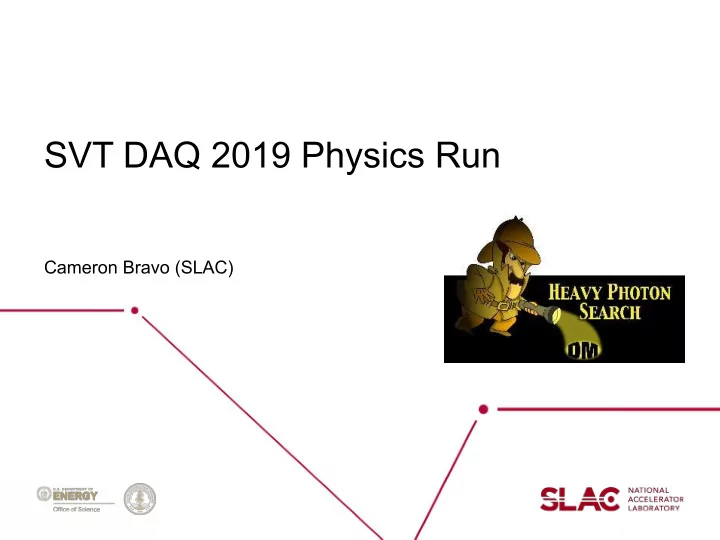

SVT DAQ 2019 Physics Run Cameron Bravo (SLAC)
Introduction • SVT DAQ system underwent a major overhaul before the run FEB bootloader image ● Rogue framework ● TI interface on PCIE cards in SVT DAQ blades (clonfarm 2 and 3) ● • Upgrades not commissioned until we started receiving beam Fixed several major issues during recovery after power outage ● – Rogue hosts channel access server to interface with EPICS – Archiving of variables to aid in investigations – Cooling FEBs to increase lifetime of LV regulation circuitry – Slow copy times in SVT event building – Improper handling of DAQ state transitions Little usable beam delivered before the outage ● Ungrounded target was crashing the DAQ during production running ● 2
SVT DAQ Overview 25m fiber Ethernet Hybrid 0 Front End RCE JLAB Board 0 Hybrid 1 Copper Crate DAQ . Hybrid 2 Flange . Copper . Hybrid 3 Ethernet . . JLAB Power Hybrid 33 Front End Slow Control Supplies Copper Board 9 Hybrid 34 25m copper Hybrid 35 Vacuum Air • 40 hybrids Raw ADC data rate (Gbps) • 16 in layers 0 – 3 (2 per module) Per hybrid 3.33 • 24 in layers 4 – 6 (4 per module) Per L1-3 Front end board 10 • 10 front end boards • Per L4-6 Front end board 13 4 servicing layers 0 – 3 with 4 hybrids per board • 6 servicing layers 4 – 6 with 4 hybrids per board • RCE crate: ATCA, data reduction, event building and JLab DAQ interface 3
SLAC Gen3 COB (Cluster on Board) 10Gbps DPM Fulcrum Board 0 Ethernet Ethernet (2 x RCE) 10Gbps Switch DPM Board 1 ATCA IPMB (2 x RCE) 1Gbps Back Power & DPM Plane Reset RTM Board 2 Switch Control (2 x RCE) & Timing Clock & DPM Dist. Board Trigger Board 3 DTM (1 x RCE) (2 x RCE) Clock / Trigger • Supports 4 data processing FPGA mezzanine cards (DPM) - 2 RCE nodes per DPM - 12 bi-directional high speed links to/from RTM (GTP) • Data transport module (DTM) - 1 RCE node - Interface to backplane clock & trigger lines & external trigger/clock source - 1 bi-directional high speed link to/from RTM (GTP) - 6 general purpose low speed pairs (12 single ended) to/from RTM • connected to general purpose pins on FPGA 4
SVT RCE Allocation • Two COBs utilized in the SVT readout system - 16 RCEs On DPMs (2 per DPM, 4 DPMs per COB) - 2 RCEs on DTMs (1 per DTM, 1 DTM per COB) • 7 RCEs on each COB process data from ½ SVT - 2019 system required COBs to be unbalanced - Dead channels on RTMs and dying FEBs • 8 th RCE on COB 0 manages all 10 FE Boards - Configuration and status messages - Clock and trigger distribution to FE boards & hybrids • 8 th RCE on COB 1 is not used 5
CODA ROC Instances On SVT Local Ethernet Network Ti DPM 7 COB0 COB1 10Gbps DATA Timing Control DATA To JLAB ROC ROC ROC ROC DAQ DTM DPM 7 DPM 5 DPM 0 DPM 5 DPM 0 TI Control Readout ... Readout Readout ... Readout Firmware Firmware Firmware Firmware Firmware Firmware JLAB FEB Hybrid Hybrid Hybrid Hybrid Triggers Control Data Data Data Data • Unbalanced load on two COBs motivated changing to have two Clock / ROCs which were not exclusive to either COB Trigger / • Balancing load on servers toward end of run greatly improved overall stability of the system! Busy 6
Rogue EPICS Bridge • Slow control software hosts an EPICS channel access server • Development of GUIs went into the run Rogue required for GUIs and can take several minutes to fully populate GUIs ● • Archiving of variables took time to coordinate • FEBs now have SEU monitoring Module implemented which can recover from SEUs ● Observed on the order of 10 SEUs per day ● Never observed an irrecoverable SEU ● • This became a strong tool for monitoring health of FEBs 7
TI PCIE Card • Interface to central trigger system at JLab achieved via a PCIE card in each of the two DAQ servers in the SVT system • Observed stability issues in FW of this PCIE card ● Locked up linux kernel multiple times ● Low jitter clock not available out-of-the-box ● One server required loading linux driver after reboot, other server would crash immediately if linux driver was loaded after reboot ● Minimal support provided • Multiple crashes required accessing hall to power cycle machines ● Reboot would not recover because PCIE card FW could only be loaded via full power cycle ● Needed ability to remotely power cycle machines 8
Server Load Balancing • Livetime was observed to be unstable, becoming more unstable as trigger rate increased • We observed all reserved memory blocks for the DAQ on the server being held only on clonfarm2 Clonfarm2 had a higher data rate than clonfarm3 ● A few iterations of shuffling around the RCE to server map proved to ● bring more stability to the system • Lowered operational point of trigger thresholds Slightly lowered trigger rate ● hps_v11 → hps_v12 trigger configuration change ● 9
Summary • Overall, we had a successful run summer 2019 ● We had a rough start ● Got on our feet ● Ran! (Now to run some analysis…) • The major issues on the SVT DAQ side have been resolved ● Still a few minor things to iron out for slow control ● Ignoring all the fried hardware for now • Interested in discussing what development is foreseen wrt the TI PCIE card ● Happening at all? ● Will the interface change? • Thanks for your attention! 10
Recommend
More recommend